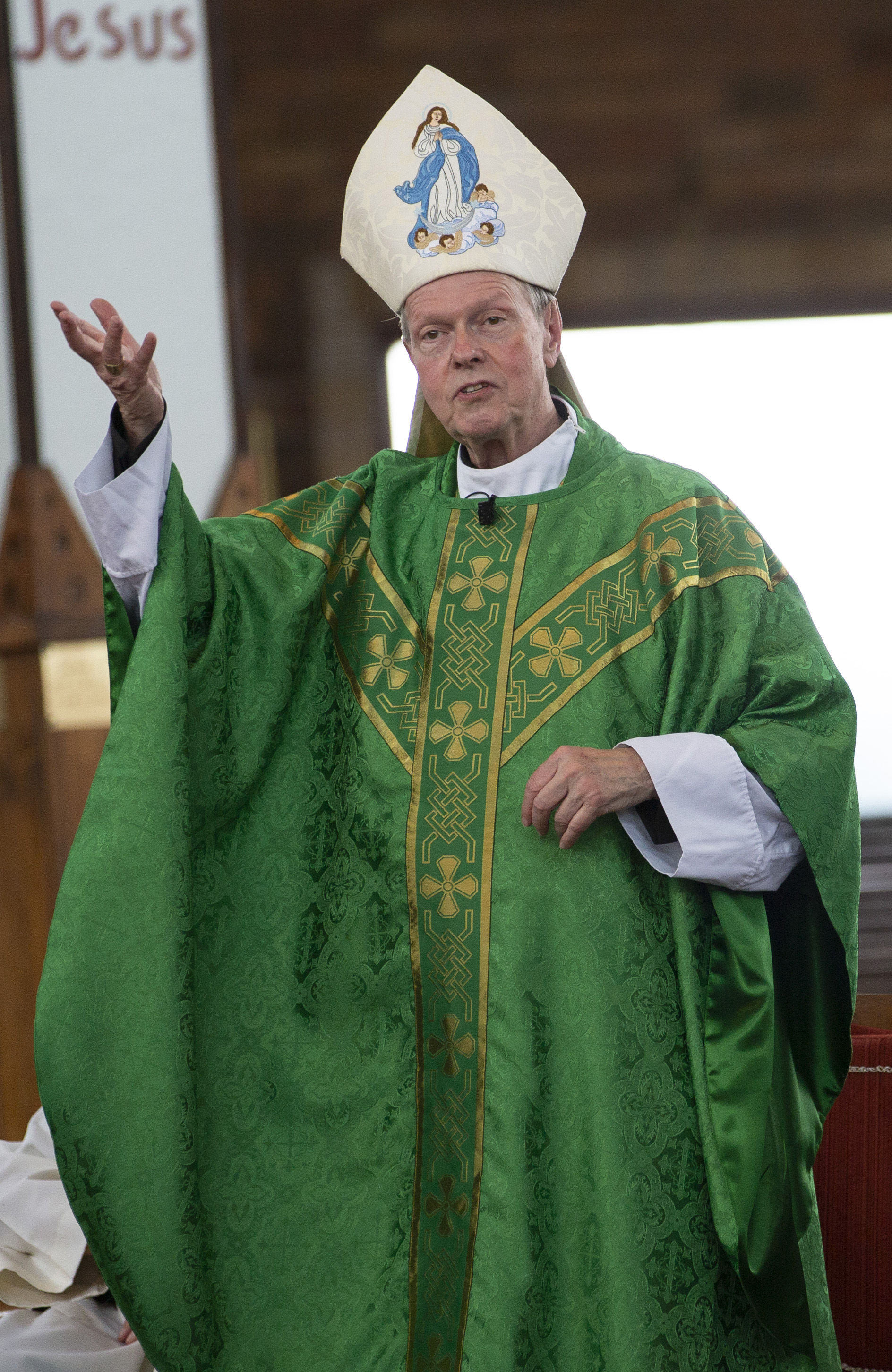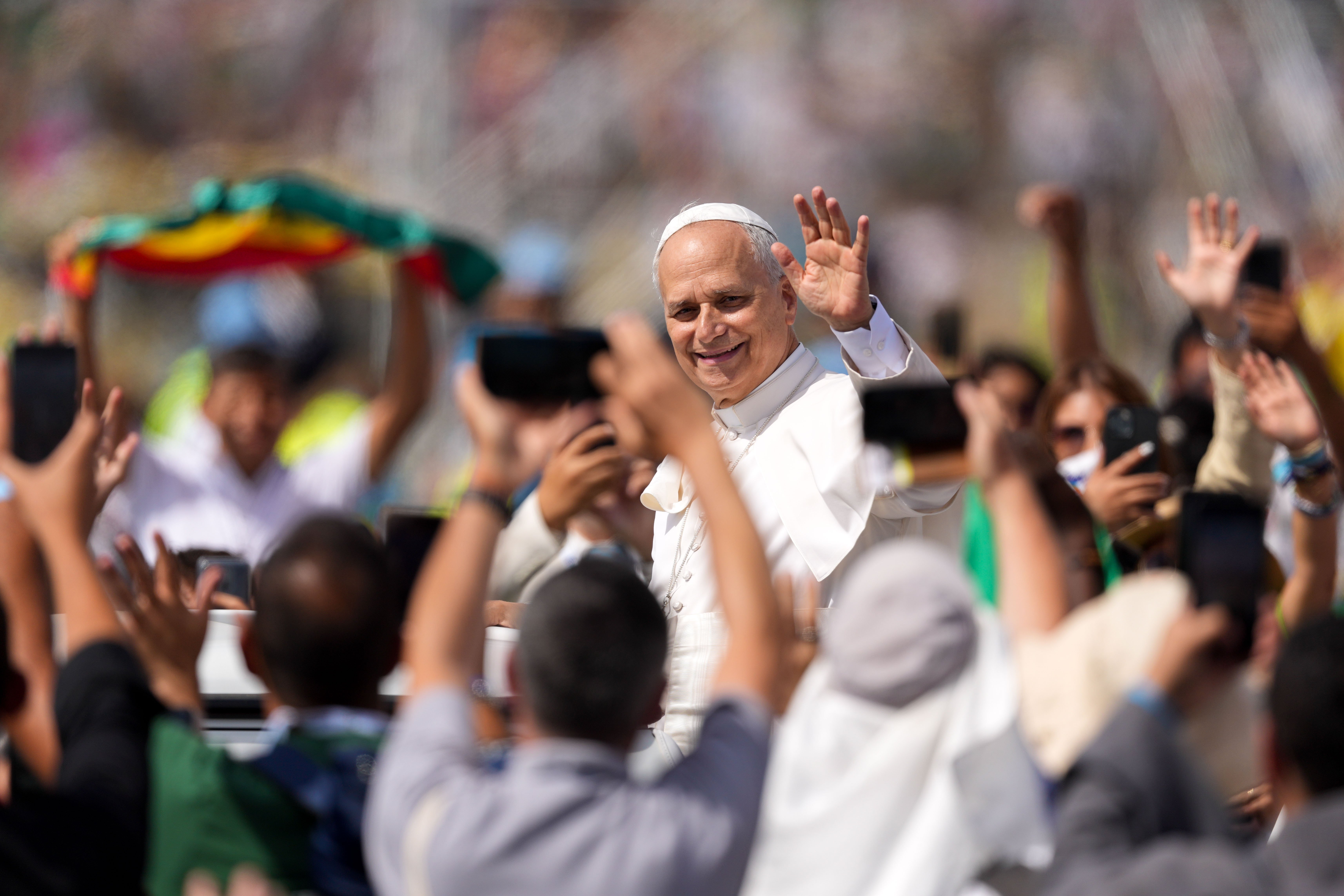April 6, 2018 at 1:53 p.m.
BISHOP'S COLUMN
Blessed Kateri a model for all
On July 14, we celebrate the Feast of Blessed Kateri Tekakwitha, "the Lily of the Mohawks," who was born in what is now Auriesville in Montgomery County. She is the only person with American Indian blood to be declared "blessed" by the Church.
I was privileged to be present at St. Peter's Basilica in Rome on June 22, 1980, for the pontifical liturgy at which Kateri was beatified. On that occasion, I had the great honor of requesting this recognition formally from Pope John Paul II, our beloved late Holy Father.
On the occasion of the 25th anniversary of her beatification, Catholics from the United States and Canada are being encouraged to remember her moving life story and to ask prayers for the miracle needed for her canonization.
At first glance, one might wonder what, if anything, the life of this quixotic Indian maiden, who lived in an historical and cultural context so radically different from our own, might have to say to our contemporary Church and society. Despite the pristine simplicity of the civilization she experienced and the rather drab ordinariness of her life, there are some lessons to be drawn from her pilgrim journey of faith.
Biography
Her life story can be captured quite succinctly. Tekakwitha was born in 1656 of an Algonquin-Christian mother and a Mohawk warrior at Ossernenon (now known as Auriesville, outside of Amsterdam, in our Diocese). She was orphaned at the age of four, when her mother and father, as well as her baby brother, were fatally stricken by a smallpox epidemic that ravaged the tribe in 1659 and 1660.
Tekakwitha, who was also stricken with the dread disease, was left with facial pock-marks, weakened eyesight and physical infirmities that plagued her for life. She was adopted by her uncle, Iowerano, chief of the neighboring village of Caughnawaga, (near present-day Fonda), where she was raised in accordance with ancestral beliefs.
Faith and Kateri
Although Tekakwitha was not baptized as an infant, she had fond memories of her good and prayerful mother, and of the stories of Christian faith that her mother shared. These remained indelibly impressed upon Kateri's mind and heart, and were to give shape and direction to her life's destiny.
At eight, in keeping with tribal custom, Tekakwitha was paired by her foster parents with a boy of the same age with a view to eventual marriage. However, she made it clear that she did not want to marry but desired to give her life to the great Manitou (that is, the true God), to whom she prayed frequently in the quiet of the wooded area near her village.
Such unusual -- indeed, almost incomprehensible -- behavior can only be explained by the powerful influence of her mother's memory and by the impulse of God's call in her life.
Baptism
Tekakwitha had only a cursory contact with Christianity during her childhood and adolescence when Jesuit missionaries would stop by her village en route to other destinations.
In 1674, however, when she was 18, Father James de Lamberville, SJ, established a permanent mission in the village and inaugurated a catechumenate program. Despite intense pressures from her foster parents and other villagers, Tekakwitha zealously pursued initiation to the Christian life. On Easter Sunday, 1676, she was baptized and given the name Kateri, the Iroquois word for her Christian name, Katharine.
Joining the religion of the white man only intensified the ridicule, calumny and hostility to which she was subjected by family and community alike, to the extent that her life was threatened. In 1677, upon the advice of Father de Lamberville and with the assistance of three catechumens, she escaped and migrated north to Caughnawaga, Canada, a Christian settlement where she was able to practice her religion in more tranquil surroundings.
Final years
Her virtue flourished in her new surroundings under the direction of the Jesuit fathers. On Christmas Day in 1677, 20 months after her Baptism, Kateri received the Eucharist for the first time. According to sacramental practice of the 17th century, it was an unusual privilege to receive the two sacraments within such a short interval.
Kateri lived just three years after this, spending most of her time caring for the sick and the elderly in the village. In 1679, with the permission of her spiritual director, she made a vow of perpetual virginity. According to her biographers, she was the first woman of the Iroquois Nation to bind herself to such a commitment.
The poor health which plagued her throughout life consumed her with violent pain and led to her death in 1680 at the tender age of 24.
Three qualities
In many ways, Tekakwitha led a very ordinary life. She did not found a religious community nor a new apostolate; she did not launch any great spiritual movement; she did not even exert much influence on those closest to her: her foster parents and fellow villagers.
But, her life was extraordinary because of three beautiful qualities she embodied in a very heroic way:
1. Kateri was a woman who understood well and accepted with patient resignation the mystery of the Cross, that mystery which proclaims that our faith is founded on the paradox of death leading to life, of suffering leading to glory, of defeat and failure leading to victory.
Kateri experienced the Cross in an orphaned childhood...a lifetime of ill health...the ridicule, scorn and rejection of her foster parents and fellow villagers...the pain and risk of leaving her homeland and launching forth into the unknown and the unpredictable...the anguish of her final excruciating illness, which took her life when the first fruits of her new-found faith were just beginning to blossom.
She accepted her trials and sufferings patiently, and bore them with love. Kateri did not allow these crosses to discourage or defeat her; instead, she saw in them an opportunity for growth, and an inspiration to work quietly and selflessly to alleviate pain and suffering in the lives of others.
In this day and age, when the pleasure-principle so dominates our society, and when people expend all kinds of time, effort and energy to remove the Cross from Christianity, and to escape the sometimes harsh realities and responsibilities of mature Christian living, Kateri Tekakwitha stands as an heroic example of how to integrate the mystery of the Cross with the mystery of the Resurrection.
2. Kateri was a woman of magnificent fortitude, dogged determination and unswerving conviction. A lesser person might well have yielded to the pressure to conform to the pervading culture: to go along with the marriage plans arranged by her foster parents...to squelch that thirst for the God of the Christians that the Holy Spirit had so copiously stirred up in her heart...to abandon her pursuit of a more intimate union with God in the interest of domestic peace and tranquility.
But, Kateri was not to be dissuaded; she was not to become the victim of human respect; she was not to sacrifice principle or conviction for expediency.
Remember, she did all of this with virtually no human support or encouragement. What a marvelous example and inspiration for all of us!
We live in a culture that runs so counter to many of our deeply held traditions and convictions. For example, any contemporary sociological survey reveals that the attitudes of American Roman Catholics about such critical moral issues as abortion, divorce, sexual ethics, embryonic stem-cell research, the death penalty, euthanasia, consumerism and poverty are not significantly different from those who have no formal religious belief whatsoever, or from those who belong to religious traditions that may have positions on these matters somewhat divergent from our own.
In the face of such harsh realities, we who follow Church teaching are frequently put on the defensive, that is, made to feel old-fashioned or irrelevant, out of step with the times, adhering to a teaching or moral view that no longer speaks to contemporary men and women.
If that be true for all of us in general, how much more so is it verified in the lives of our young people today. Our teenagers and young adults are bombarded constantly with pressures to conform with the latest fad, fashion or movement: drugs, alcohol, the newest philosophy, art form, cult experience.
They are told in so many ways, both subtly and not so subtly, "You've got to go along to get along; you've got to compromise and give in a bit if you are to gain acceptance, popularity and credibility." They are encouraged incessantly to substitute money for concern, style for substance, things for self and sex for love.
The rates of abortion, out-of-wedlock pregnancies, venereal disease, alcoholism, drug abuse, crime, juvenile delinquency and abandonment of religious practice among teenagers and young adults reveal how devastating those pressures can be.
The young, as well as we who are called to be their teachers and role models, need to be strong and courageous. We need to be counter-witnesses to the prevailing culture and mindless wisdom of the age. Above all, we need to believe deep in our hearts that Christian values and ideals are truly possible and attainable in the midst of 21st-century living.
What better example, model and inspiration could we have than Kateri Tekakwitha, who almost single-handedly defied the social conventions of her day and made a radical conscience decision to follow that God who was made known to her in the most difficult and unlikely circumstances?
3. Kateri was a woman of great prayer, a woman who had a deep and abiding awareness of the Lord's love for her, and an ongoing personal relationship with Him. How else but through her life of prayer can we explain her extraordinary faith response?
Just as prayer was a key to Kateri's life, it must also be the foundation of our lives today, however busy, hectic and frenzied they may be.
I underscore this because we tend to be very activist these days; we tend to become so involved with the here and now, or so caught up with doing for ourselves or others, that we frequently excuse ourselves from prayer or make prayer a second or third priority in our lives.
What a tragic mistake that is, for if there is no prayer in our lives, there is no God in our lives. If we do not take the opportunity to pray regularly, no matter what the pretense or excuse, no matter how deeply preoccupied we may be, then for all practical purposes we are atheists. In other words, if we do not pray, we do not know who the Lord is nor in which direction He is calling us in our everyday lives.
Furthermore, without prayer, we are unable to transcend the many frustrating, unpleasant and at times totally incomprehensible aspects of our human existence. We are unable to bring to those with whom we live and work, and to those whom we are called to serve, the love of the Lord whom we have met and known in our own moments of prayer and reflection.
Father Karl Rahner, the renowned Jesuit theologian, stated recently that, in a world that offers little institutional support for organized religion, the only Christians in the future will be those who have had an experience of God. As Kateri's life so well demonstrates, prayer is the only way to gain that experience and lead others to our God.
Knowing Kateri
During these summer days, I encourage all from our Diocese to visit the sacred grounds of the Shrine of the North American Martyrs in Auriesville and of the National Kateri Shrine in Fonda in order to learn more about Kateri's life and times, and to be uplifted and inspired by her heroic virtues.
I also hope that a renewed interest in Kateri will make us more conscious of the needs of our Native American brothers and sisters, Kateri's physical and spiritual descendants, who have been so exploited by personal and national greed, paternalism, racism and broken promises.
There is no better way in which we can honor Kateri's memory than by supporting the priests, religious and laity working among Native Americans, especially through assistance to the Bureau of Catholic Indian Missions, and by recommitting ourselves to alleviate the injustices suffered by our Native Americans so that they can taste the fruit of life, liberty and the pursuit of happiness that are our national heritage.
Finally, I hope that we in this Diocese where Kateri has such deep roots will pray for her canonization so that her life of faith, love and service will be recognized and acclaimed by the entire Church, and so that our Native American brothers and sisters will have a special patron saint.
(Prayer for the Canonization of Blessed Kateri Tekakwitha: "O God, who, among the many marvels of Your Grace in the New World, did cause to blossom on the banks of the Mohawk and of the St. Lawrence, the pure and tender Lily, Kateri Tekakwitha, grant we beseech You, the favor we beg through her intercession; that this Young Lover of Jesus and of His Cross may soon be counted among her Saints by Holy Mother Church, and that our hearts may be enkindled with a stronger desire to imitate her innocence and faith. Through the same Christ our Lord. Amen." Recite the Our Father and Hail Mary once, and Glory be to the Father three times.)
(7/14/05) [[In-content Ad]]
MORE NEWS STORIES
- Indian nuns released on conditional bail; advocates, superiors call their arrest ‘unlawful’
- ‘Rerum Novarum’ 2.0? Catholic labor advocates heartened by direction of Pope Leo XIV
- Pope visits teen who fell ill during Jubilee of Youth, prays with family
- Journey together, seek real encounters, pope advises young people
- Irish lay missionary kidnapped from orphanage in Haiti
- West Virginia bishop warns on immigration: ‘The final judge of our actions is God’
- Pope offers prayers after shipwreck of migrant boat off Yemen
- Peace, disarmament begin in the heart, says Archbishop Broglio
- Catholic MBA programs see business as force for good, blending doctrine, commerce
- Trump administration moves to reinstate VA health policy fully excluding abortion








Comments:
You must login to comment.